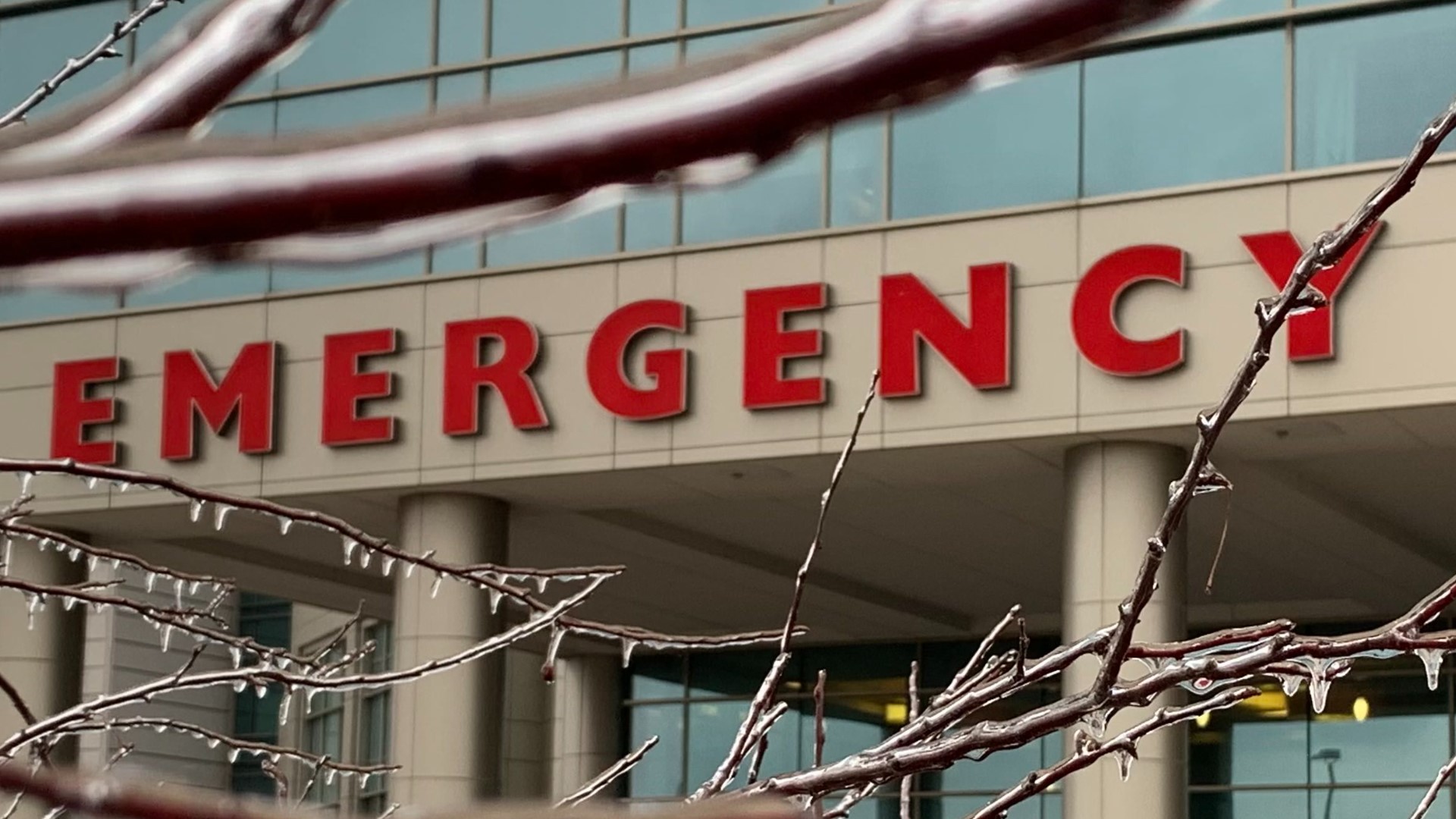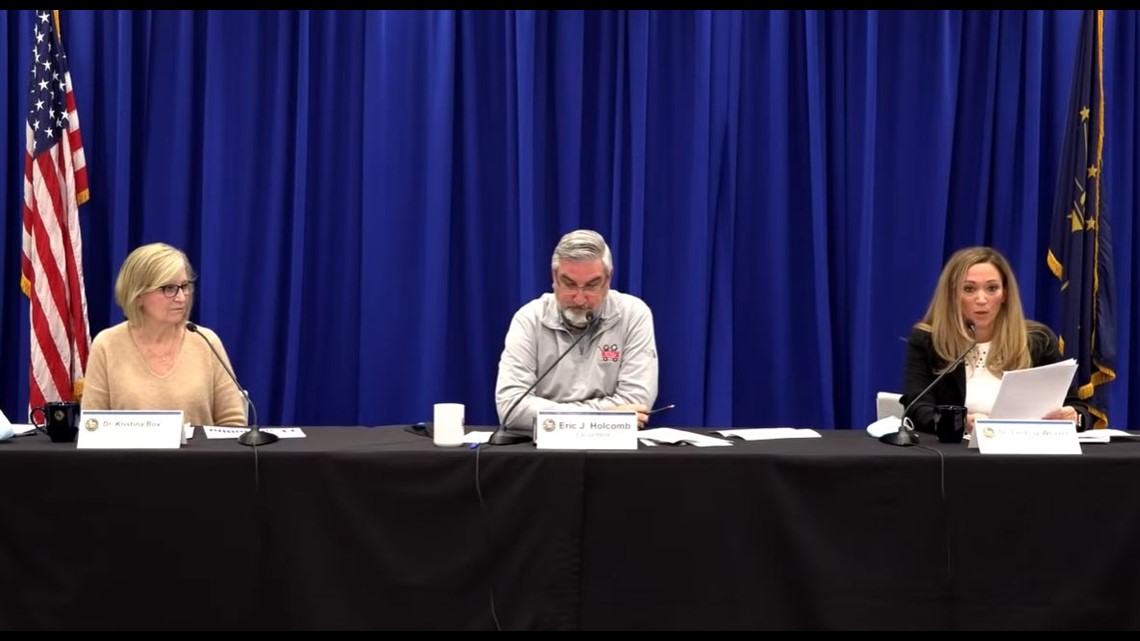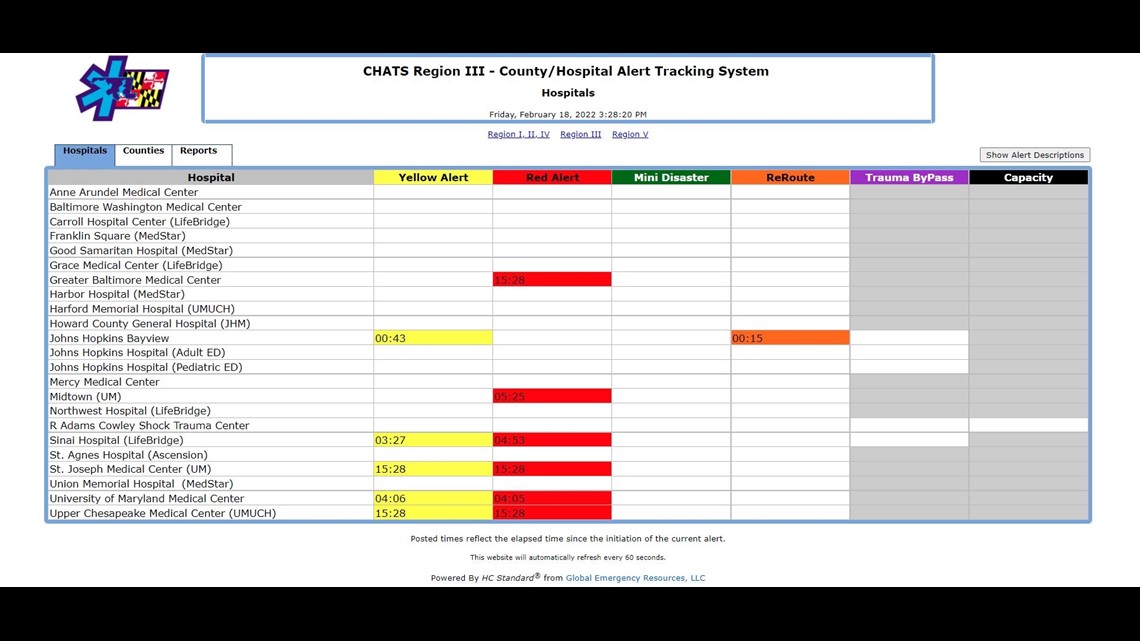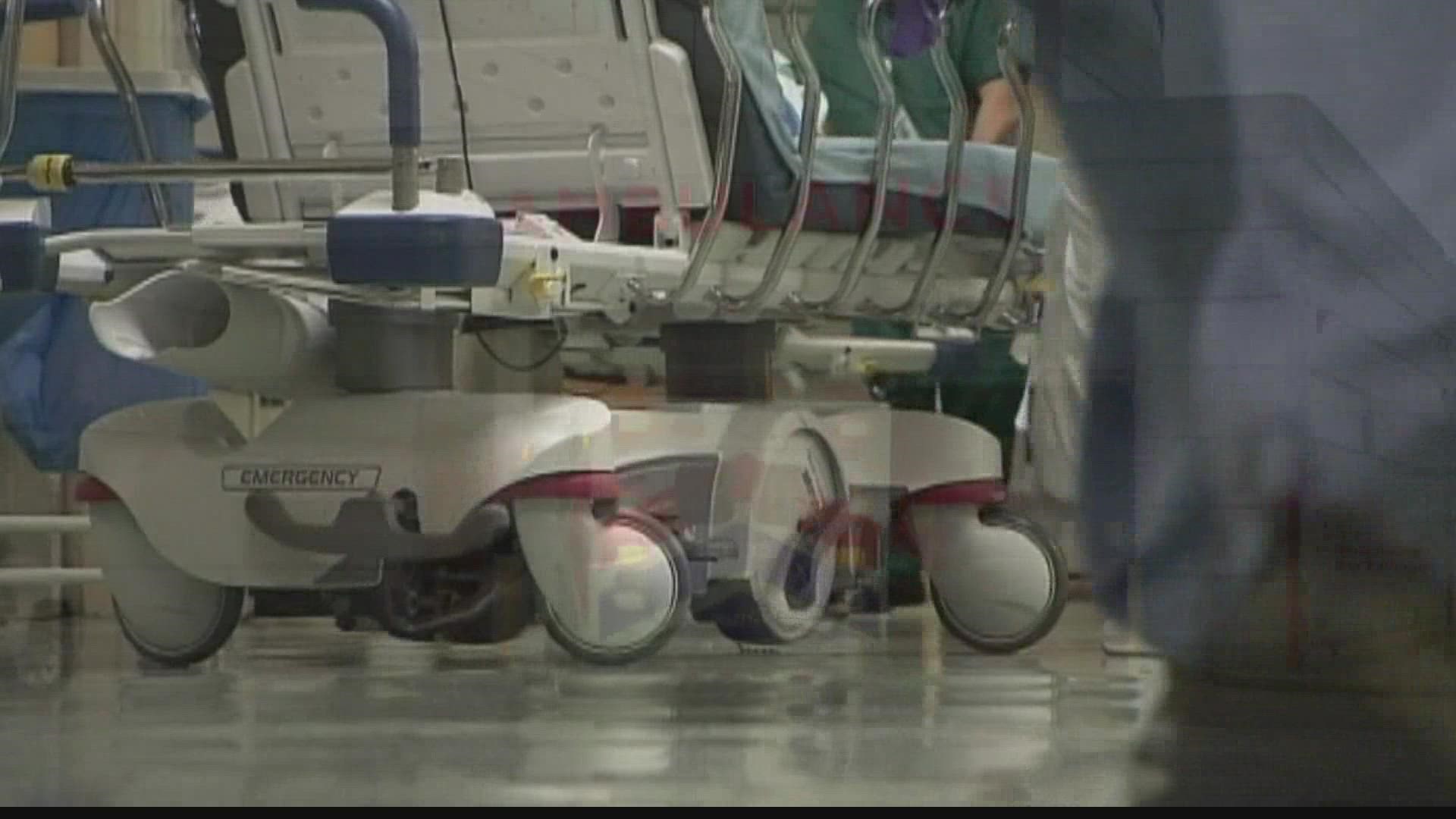Indiana hides its hospital diversion info, other states post it online
Data obtained by 13 Investigates shows Indiana hospital emergency rooms and intensive care units declared diversion status for tens of thousands of hours last fall.

This winter, with nearly 10,000 daily visitors to Indiana emergency rooms, many hospitals across the state struggled.
In late December, the Indiana Department of Health’s chief medical officer painted a grim picture of overcrowding.
“We are often seeing patients being held in the emergency room for hours and sometimes days until a bed becomes available,” said Dr. Lindsay Weaver, adding that “patients are being cared for in hallways and conference rooms.”
A few days later, the Indiana Hospital Association announced Hoosier hospitals were "overwhelmed" and in a "state of crisis with dwindling capacity left to care for patients.”
The crisis prompted many Indiana hospitals to move to "diversion," a request to ambulances and paramedics to take their incoming patients somewhere else.
Statewide data obtained by 13 Investigates shows hospital emergency rooms and intensive care units across Indiana declared diversion status for tens of thousands of hours last fall, even before a rapid increase in COVID-19 cases prompted much worse overcrowding in December and January. Some hospitals remained in round-the-clock diversion status for days — even weeks — at a time.
Then, the data suddenly stopped.
While Indiana hospitals are required to report their diversion status to the Indiana Department of Health every day, a 13News investigation finds the state health department will not release the information to the public. WTHR has also discovered state health officials do not keep the hospital diversion data they are mandated to collect — even at the height of a pandemic-fueled crisis.
And the decision to withhold information about ER and ICU diversion status from Indiana residents while also allowing historical data to disappear comes as a sharp contrast to the transparency shown by other states that post hospital diversion information in real time, where it can be utilized by both ambulance crews and residents seeking health care.
What diversion means, why it matters
Diversion is a term that paramedics do not like to hear and a scenario that all hospitals try to avoid.
“Our goal is always to stay off diversion for many reasons,” Dr. Graham Carlos, the executive medical director at Eskenazi Hospital, told 13News in December. “When we’re on diversion, we’re not able to accept new patients the way we want to and, unfortunately, this pandemic has filled up our hospitals and caused us to be diversion more than in the past.”
Diversion is a signal from an individual hospital to EMS crews, alerting them that their emergency room or intensive care unit (or both) is full. It is not a demand, but instead a non-binding request asking ambulances to take their hospital-bound patients to another medical facility for treatment.
Declaring diversion status does not mean an ER or ICU is closed. Ambulances can still choose to transport a patient to the closest facility that will meet the level of care required, and patients who walk into an emergency room needing urgent care are not turned away – even if the facility is on diversion.
“Hospitals are going to take care of patients 24 hours a day, seven days a week, when they walk through the doors of that emergency room. They are going to be treated,” explained Brian Tabor, president of the Indiana Hospital Association. “The strain on the system is tremendous, so what diversion is about is really more of a system management tool. It’s basically a way that the system talks to itself about where the pressure points are so that ambulances can move around.”
Tabor says patients who arrive at an emergency room while it is in diversion status will be evaluated upon arrival – just as they would be if the hospital were not busy – and patients exhibiting life-threatening medical conditions will continue to be prioritized over those with less serious emergencies.
It means patients requiring medical care for non-life-threating medical conditions might need to wait many hours or even days for care at an emergency room that has activated diversion. Even very seriously ill or injured patients who might normally get immediate ER care might need to wait much longer to receive necessary treatment if there are several more urgent cases ahead of them. Faced with those scenarios, hospitals can turn to diversion and request that EMS crews transport incoming patients elsewhere as a strategy to minimize further overcrowding and reduce long delays for patients.
The practice, which was once incredibly rare in Indiana, became so widespread during the COVID-19 pandemic that state health officials decided to take action to better track the extent of hospital diversions across Indiana.
Indiana now collects diversion info every day


Last September, as emergency rooms began to see record levels of patients, Indiana Governor Eric Holcomb signed an executive order that requires hospitals to report their diversion status to the state health department. The order mandates the “number of hours spent in diversion for Emergency Departments and critical care units for the previous day must be reported daily” to the Indiana Department of Health to allow for capacity and resource availability monitoring.
A few weeks after the governor signed the executive order, 13News submitted a request to the state health department under Indiana’s Access to Public Records Act, seeking the diversion data it collected from Indiana hospitals.
It took the Indiana Department of Health 79 days to provide the first set of diversion data to 13News. That data showed some Indiana hospitals spent a staggering amount of time in diversion status from August 31 to October 13, 2021, the period for which IDOH released data.
Among key takeaways:
- During the reporting period, 58 of 83 Indiana hospitals (70%) reported their ER or ICU being in diversion status
- In September alone, Indiana hospitals reported 8,504 hours of emergency room diversion and 10,266 hours of ICU diversion
- 23 hospitals spent an average of at least six hours on ER diversion every day in September, and nine hospitals averaged at least 12 hours on daily ER diversion that month
- 26 hospitals averaged at least six hours of ICU diversion every day in September, and 14 hospitals spent an average of at least 12 hours on ICU diversion every day
- Some hospitals were on round-the-clock ICU diversion almost every day. Terre Haute Regional Hospital, for example, reported 41 straight days of 24-hour ICU diversion during the reporting period
- Some hospitals were on nearly constant ER diversion for many consecutive days. Good Samaritan Hospital in Knox County, for example, reported 24-hour ER diversion for 35 out of 41 days during the reporting period
- Hospitals in northwest Indiana recorded the highest number of ER diversion hours while hospitals in the Indianapolis metro area experienced the most ICU diversion hours
The data did not come as a surprise to the state’s hospital association.
“Nearly all hospitals in almost every region of the state had been in diversion probably more than not,” Tabor told 13News in late January. “We’ve been seeing record levels, far above anything we’ve seen before.”
As hospitals continued to struggle with an onslaught of pandemic-related hospital visits, 13News continued to submit requests for diversion data collected daily by the state health department.
The Indiana Department of Health has since denied each of those requests, choosing to keep the state’s diversion data secret and withholding it from public view.
Here today. Gone tomorrow.
In December, IDOH media relations coordinator Megan Wade-Taxter informed 13News that the diversion data reports previously provided to 13 Investigates were generated by an IDOH employee with information collected from the state’s diversion data system.
“IDOH stopped creating those reports to focus staff time on other COVID response issues,” Wade-Taxter wrote as she denied 13News’ request for additional diversion data. “IDOH cannot generate reports with all of the information for historic time periods because the system itself does not do that. The system is designed to be a current snapshot. We are not running the reports on a regular basis and we are not required to create these reports in response to a public records request.”
Since mid-October, IDOH says it has generated hospital diversion reports for only four days, and the department has provided diversion reports to 13News for each of those days.
But 13 Investigates did not ask for the state health department to create any reports. 13News requested the actual diversion data that, according to executive order, IDOH must collect daily from Indiana hospitals. That data is subject to public release under the Indiana Access to Public Records Act, whether the state health department chooses to use the data or not.
Based on IDOH’s response, it appears the state has not been saving the daily diversion data it is required to collect – even during periods described as a crisis. IDOH has not explained why its computer system is not capable of capturing and saving the historical data.
“[T]he data system can only export the last 24 hours of diversion data,” said ISDH public affairs director Jennifer O’Malley, suggesting the data either disappears or cannot be accessed after 24 hours. 13News has filed a formal complaint with Indiana’s Public Access Counselor, alleging the health department’s choice to not retain the public data it is required to collect for more than a day is a violation of the state’s public access law.
Other states not only collect and retain their hospital diversion information, but also provide instant public access, allowing residents to see the information in real time.
“A better plan”


While Indiana hides its diversion data from the public – sharing it only internally between hospitals and EMS crews – other states handle the information differently.
The Georgia Coordinating Center collects emergency room and intensive care unit status information from hospitals across Georgia and presents the data in a searchable, user-friendly online dashboard that is updated every 60 seconds. The dashboard indicates whether a hospital’s current status is considered normal, busy, overcrowded or severe; and if the hospital has declared a diversion status, the dashboard also shows which areas of the hospital are impacted by the diversion.
A spokeswoman for the Georgia health department says the diversion status information was created and is intended for ambulance crews, but it is available online where anyone can see it.
The same type of information is also available in other states, with online sites that offer public hospital diversion information in Pennsylvania, Mississippi, Alaska and Maryland.


Maryland’s online system, called the County/Hospital Alert Tracking System or CHATS, has been available for two decades. It shows which hospitals are in “Yellow Status,” which means their ERs are requesting no new patients in need of urgent medical care, and which are in “Red Status,” indicating all their ICU beds are full.
“It’s a way the hospitals can alert the emergency medical system when their emergency departments are particularly busy,” said Ted Delbridge, executive director of the Maryland Institute for Emergency Medical Services Systems, the agency that operates CHATS.
He said discussions about whether to keep the hospital information public or to make it private have always ended in the same conclusion.
“Making it publicly available, we just think that's a better plan,” Delbridge told 13News. “It keeps the healthcare system accountable to itself. The hospitals and the EMS system knows the public can view the information and it makes them try to keep it as real time and legitimate as they possibly can.”
Some emergency room doctors here in Indiana say there's another benefit to releasing diversion information: community awareness.
“I think it's good to be open handed with that data, even if it's not in real time but very close to it, so people can have an understanding what's going on in their city, what hospitals are full, what hospitals have capacity,” said Carlos, Eskenazi Hospital’s medical director who also serves as an ER physician. “Knowing what our hospital capacity is, especially now on the heels of a two-year pandemic, is an important metric for us all to keep track of as a community.”
The same level of transparency is not available in Indiana, and state health leaders insist it should stay that way.
Why Indiana does not want you to see hospital data
If your loved one is having a heart attack, surfing the internet to try to determine which local ERs are on diversion is both unnecessary and not a good idea. In a life-threatening emergency, medical experts insist the best course of action is to call 911 and to get to the nearest emergency room. Even if the ER is on diversion, the most serious emergencies are handled first and patients who show up are not turned away.
But in a non-life-threatening emergency – say your daughter breaks her leg while playing soccer – would you want to know which nearby hospitals are on diversion and which are not, especially if an extra 10-minute drive could prevent hours of additional wait time in a hospital emergency room?
State health officials have access to that type of diversion information, but they won't tell you. Indiana State Health Commissioner Dr. Kristina Box believes diversion information is intended solely for EMS crews.
“We actually don't want people picking and choosing which hospitals they go to based on diversion data,” she said during a September 2021 media briefing. “The diversion data, when we take a snapshot of it at any particular time, it's really obsolete within the next 5 to 10 minutes because that's how quickly it changes.”
Indiana hospitals are not eager to share their diversion data either — especially if it means providing real-time diversion data like the systems in Georgia and Maryland, so the public can track the changes in ERs and ICUs as they happen.
“I would have real concerns about that,” said Tabor, the Indiana Hospital Association president. “An individual patient should not be making a decision about which emergency room to go to based on a dashboard that was meant for a completely different purpose for a completely different audience.”
He says diversion data is best interpreted by a medical professional like a paramedic who has proper training to first evaluate a patient’s medical condition. Tabor worries that patients who gain access to real-time diversion data could die if they choose to bypass the closest emergency room – or to not seek medical care at all – because they see it is on diversion.
“We really want people in an emergency to get to the closest point of emergency level care, and I worry that a dashboard with a red light or however it might be portrayed might make someone think of a stop sign or a sign that says ‘closed for business’ and think that hospital is not going to be able to take care of them,” he explained.
Delbridge, who oversees Maryland’s online hospital alert system that is accessible to the public, says he does not share that same concern based on two decades of experience.
“We’re not aware of any circumstances where a patient faced with an emergency has gone to the internet to find where the [diversion] information can be viewed … and then has gone out of their way, processing that information, to go someplace further away and had a negative event because of that,” he told 13News. “We’ve had the system in place for 20 years, and it just doesn’t happen that way.”
Asked if there have been any reported incidents of negative healthcare outcomes since Georgia started posting its hospital diversion data online, Georgia officials have not provided 13News with any such examples.
“If the information is presented in a way that explains to them what they're looking at, [the public] can make a reasonable judgment for themselves,” Delbridge said. “More information is better.”
13News is continuing to request Indiana’s hospital diversion data from Indiana Department of Health, because we believe state residents have a legal right to see the data. The state Public Access Counselor told 13 Investigates he is in contact with the health department, advocating that IDOH release the data requested by 13News.


